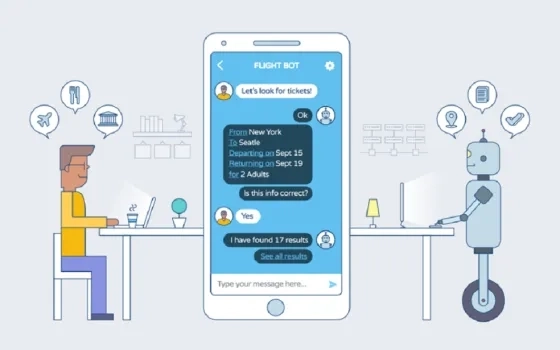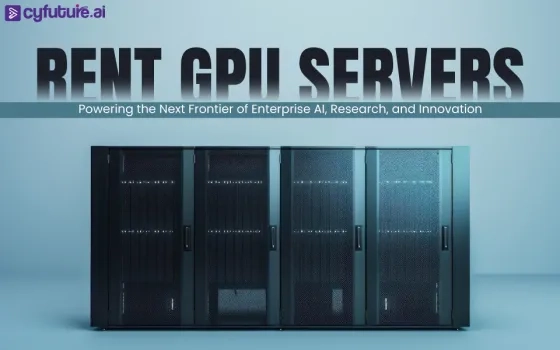What is a Conversational Chatbot?
As the name suggest, a chatbot is a software that can chat with a user through telephone, messaging applications, mobile apps or via the websites. A chatbot is often considered as one of the most advanced and brilliant expressions of communication between humans and machines. From a technological viewpoint, a chatbot signifies the natural evolution of a question answering system, leveraging NLP or Natural Language Processing. Formulating replies to questions in natural language is one of the most typical instances of Natural Language Processing applied in a range of enterprise's end-use applications. Chatbot therefore can also be understood as a virtual agent that can speak with and share basic insights with customers, an attendant that can be integrated with instant messengers, websites, IVRs or mobile applications and assists businesses to connect directly with customers.
Why Conversational Chatbots are needed for business?
Both businesses and consumers benefit greatly from the chatbots, some of those benefits are mentioned below:
• Customers get an impersonal channel to communicate with companies
• ChatBots are available 24X7 as a platform for communication between companies and their customers
• Customers can get the primary level of information related to their concerns from the Bot.
• A ChatBot integrated with a knowledge management tool can help companies share exhaustive information related to service procedures, product information, etc, with ease. For example, a healthcare company can share medical procedure-related details, dos and don'ts in an exhaustive document over the chatbot, or a product company can send technical details, troubleshoot information, etc over the bot.
Types of Conversational Chatbots
Chatbots can be classified broadly into three types:
• Menu/Button based chatbots
• Keyword recognition based chatbots
• Contextual chatbots
The Menu/Button based chatbots are like decision tree and requires the users to select a menu/button to navigate to different selections.
Keyword recognition and Contextual chatbots use NLP to determine the user utterance and direct it towards the best suited response. The contextual chatbots harness the Machine Learning (ML) capability to remember conversations and context of the conversations to provide a more personalised experience.
According to Comm100, The average satisfaction rate of bot-only chats is 87.58%
About NLP Chatbot
Computers traditionally require humans to "speak" to them in a programming language that is precise, unambiguous and highly structured, or through a limited number of clearly enunciated voice commands. Human speech, however, is not always precise -- it is often ambiguous and the linguistic structure can depend on many complex variables, including slang, regional dialects and social context. NLP ChatBot are for this reason special cause they are trained to understand complex variables of human speech and their social context and made to respond accordingly.
NLP engines rely on the following elements in order to process queries –
• Intent – The central concept of constructing a conversational user interface and it is identified as the task a user wants to achieve or the problem statement a user is looking to solve.
• Utterance – The various different instances of sentences that a user may give as input to the chatbot as and when they are referring to an intent.
• Entity. They include all characteristics and details pertinent to the user's intent. This can range from location, date, time, etc.
• Context. This helps in saving and share different parameters over the entirety of the user's session.
• Session. This essentially covers the start and end points of a user's conversation.
So with NLP engine, the chatbot is able to understand input, translate it into language that computers can understand and provide suitable response as trained by the data set.
This can be best explained using the example below.
Natural Language Processing allows chatbots to understand your messages and reply suitably. Suppose you send a “Hi” to a chatbot, NLP will enable the bot to understand that you have written a standard greeting, and the AI capabilities of the bot clubbed with NLP will help the Chatbot formulate a suitable response. In this case, the chatbot will return the message with a greeting.
It is important to keep in mind that devoid of NLP, a chatbot cannot differentiate between the responses “Hi” and “Bye” significantly. Training a chatbot for natural language processing is however a continuous process and in the initial stages an NLP based chatbot may stumble more than after it has been trained to answer repetitive queries. To avoid this we suggest companies to start with a rule based chatbot and upgrade to an NLP chatbot only after it has been trained well to handle scenarios they encounter frequently. A rule based Chatbot is designed to understand some key words and reverts to incoming messages with the response feeded in it
How does Conversational Chatbot work?
The capability to recognize the user's intention and take out data and related entities contained in the user's request, also known as information gathering is the first condition and the most critical step at the centre of a chatbot. If the bot is unable to understand the user's request appropriately, it will not be able to offer an accurate answer.
Returning the answer: After the intent of the user has been identified, the chatbot must offer the most suitable response for the user's request. The response might be:
• a text retrieved from a knowledge base that comprises perse answers
• a predefined and generic text
• a contextualized piece of information based on data the user has offered
• the outcome of an action that the chatbot performed by interacting with one or more backend application
• data stored in enterprise systems
• a disambiguate question that assists the chatbot to properly understand the request of the user
Significance of Conversational Chatbots
Chatbot applications rationalize interactions between people and services, improving customer experience. At the same time, they provide companies new opportunities to enhance the customers' engagement procedure and operational efficiency by reducing the usual cost of customer service.
To be unbeaten, a chatbot solution should be able to perform the tasks effectively. Human support plays a significant role here: Irrespective of the kind of platform and approach, human intervention is crucial in training, configuring and optimizing the chatbot system.
Which Conversational Chatbots are ideal for you?
There are a number of tools and approaches you can use to develop a chatbot. Based on the use case you want to address, some chatbot technologies are more suitable than others. To achieve the desired results, the blend of different AI forms for instance machine learning, natural language processing and semantic understanding may be the most excellent option.
When deciding which chatbot is right for your organisation, place yourself in the shoes of your users and think about the value they are trying to receive.
• Is conversation context going to significantly impact this value?
• What is your users UX preferences? Some users prefer to have the chatbot guide them with visual menu buttons rather than an open-ended experience where they are required to ask the chatbot questions directly.
The right chatbot is the one that best fits the value proposition you are trying to convey to your users. In some cases, that could require enterprise-level AI capabilities; however, in other instances, simple menu buttons may be the perfect solution. A chatbot as discussed above is a service, powered by rules and at times artificial intelligence that people can communicate with via a chat interface or voice interface. Chatbots are used for marketing systems and basic customer service often that frequent social networking hubs and instant messaging clients.
Conclusion:
Chatbot is redefining customer experience and has become pervasive across various touch points of customers. With the aid of AI and ML, it is becoming smarter by the day and conversational chatbot becomes quite engaging and useful. However, users may sometimes wish to be connected to live agents and the chatbot should have capability to seamlessly transfer the interaction to live chat or live call agents, as the case maybe.
Read more about the AI based NLP Chatbot from C-Zentrix.































